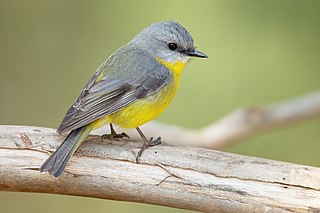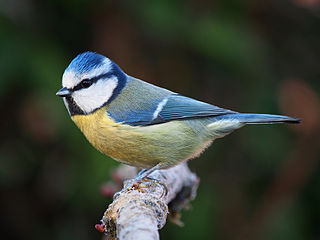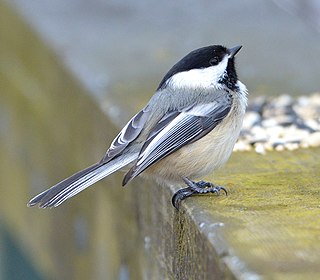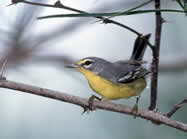
In evolutionary biology, reciprocal altruism is a behaviour whereby an organism acts in a manner that temporarily reduces its fitness while increasing another organism's fitness, with the expectation that the other organism will act in a similar manner at a later time.

A songbird is a bird belonging to the suborder Passeri of the perching birds (Passeriformes). Another name that is sometimes seen as the scientific or vernacular name is Oscines, from Latin oscen, "songbird". The Passeriformes contains 5,000 or so species found all over the world, in which the vocal organ typically is developed in such a way as to produce a diverse and elaborate bird song.

The snow bunting is a passerine bird in the family Calcariidae. It is an Arctic specialist, with a circumpolar Arctic breeding range throughout the northern hemisphere. There are small isolated populations on a few high mountain tops south of the Arctic region, including the Cairngorms in central Scotland and the Saint Elias Mountains on the southern Alaska-Yukon border, as well as the Cape Breton Highlands. The snow bunting is the most northerly recorded passerine in the world.

The Eurasian blue tit is a small passerine bird in the tit family, Paridae. It is easily recognisable by its blue and yellow plumage and small size.

The great tit is a passerine bird in the tit family Paridae. It is a widespread and common species throughout Europe, the Middle East, Central Asia and east across the Palearctic to the Amur River, south to parts of North Africa where it is generally resident in any sort of woodland; most great tits do not migrate except in extremely harsh winters. Until 2005 this species was lumped with numerous other subspecies. DNA studies have shown these other subspecies to be distinct from the great tit and these have now been separated as two distinct species, the cinereous tit of southern Asia, and the Japanese tit of East Asia. The great tit remains the most widespread species in the genus Parus.

The parrotbills are a family, Paradoxornithidae, of passerine birds that are primarily native to East and Southeast Asia, though feral populations exist elsewhere. They are generally small, long-tailed birds that inhabit reedbeds and similar habitats. They feed mainly on seeds, e.g. of grasses, to which their bill, as the name implies, is well-adapted. Living in tropical to southern temperate climates, they are usually non-migratory.

The great reed warbler is a Eurasian in the passerine genus Acrocephalus.

Bird vocalization includes both bird calls and bird songs. In non-technical use, bird songs are the bird sounds that are melodious to the human ear. In ornithology and birding, songs are distinguished by function from calls.

The northern mockingbird is a mockingbird commonly found in North America. This bird is mainly a permanent resident, but northern birds may move south during harsh weather. This species has rarely been observed in Europe. This species was first described by Carl Linnaeus in his 1758 10th edition of Systema Naturae as Turdus polyglottos. The northern mockingbird is known for its mimicking ability, as reflected by the meaning of its scientific name, "many-tongued mimic". The northern mockingbird has gray to brown upper feathers and a paler belly. Its tail and wings have white patches which are visible in flight.

The black-capped chickadee is a small, nonmigratory, North American songbird that lives in deciduous and mixed forests. It is a passerine bird in the tit family, the Paridae. It is the state bird of Massachusetts and Maine in the United States, and the provincial bird of New Brunswick in Canada. It is well known for its ability to lower its body temperature during cold winter nights, its good spatial memory to relocate the caches where it stores food, and its boldness near humans.

Babbling is a stage in child development and a state in language acquisition during which an infant appears to be experimenting with uttering articulate sounds, but does not yet produce any recognizable words. Babbling begins shortly after birth and progresses through several stages as the infant's repertoire of sounds expands and vocalizations become more speech-like. Infants typically begin to produce recognizable words when they are around 12 months of age, though babbling may continue for some time afterward.
The marginal value theorem (MVT) is an optimality model that usually describes the behavior of an optimally foraging individual in a system where resources are located in discrete patches separated by areas with no resources. Due to the resource-free space, animals must spend time traveling between patches. The MVT can also be applied to other situations in which organisms face diminishing returns.

Animal song is not a well-defined term in scientific literature, and the use of the more broadly defined term vocalizations is in more common use. Song generally consists of several successive vocal sounds incorporating multiple syllables. Some sources distinguish between simpler vocalizations, termed “calls”, reserving the term “song” for more complex productions. Song-like productions have been identified in several groups of animals, including cetaceans, avians (birds), anurans (frogs), and humans. Social transmission of song has been found in groups including birds and cetaceans.

Mate choice is one of the primary mechanisms under which evolution can occur. It is characterized by a "selective response by animals to particular stimuli" which can be observed as behavior. In other words, before an animal engages with a potential mate, they first evaluate various aspects of that mate which are indicative of quality—such as the resources or phenotypes they have—and evaluate whether or not those particular trait(s) are somehow beneficial to them. The evaluation will then incur a response of some sort.
The Cameroon indigobird is a species of bird in the family Viduidae. It is considered by some authors to be a subspecies of the variable indigobird. They range from Sierra Leone to east Cameroon, north east Zaire and South Sudan.
A mating call is the auditory signal used by animals to attract mates. It can occur in males or females, but literature is abundantly favored toward researching mating calls in females. In addition, mating calls are often the subject of mate choice, in which the preferences of one gender for a certain type of mating call can drive sexual selection in a species. This can result in sympatric speciation of some animals, where two species diverge from each other while living in the same environment.
The challenge hypothesis outlines the dynamic relationship between testosterone and aggression in mating contexts. It proposes that testosterone promotes aggression when it would be beneficial for reproduction, such as mate guarding, or strategies designed to prevent the encroachment of intrasexual rivals. The positive correlation between reproductive aggression and testosterone levels is seen to be strongest during times of social instability. The challenge hypothesis predicts that seasonal patterns in testosterone levels are a function of mating system, paternal care, and male-male aggression in seasonal breeders.
Polygyny is a mating system in which one male lives and mates with multiple females but each female only mates with a single male. Systems where several females mate with several males are defined either as promiscuity or polygynandry. Lek mating is frequently regarded as a form of polygyny, because one male mates with many females, but lek-based mating systems differ in that the male has no attachment to the females with whom he mates, and that mating females lack attachment to one another.

Sexual selection in birds concerns how birds have evolved a variety of mating behaviors, with the peacock tail being perhaps the most famous example of sexual selection and the Fisherian runaway. Commonly occurring sexual dimorphisms such as size and color differences are energetically costly attributes that signal competitive breeding situations. Many types of avian sexual selection have been identified; intersexual selection, also known as female choice; and intrasexual competition, where individuals of the more abundant sex compete with each other for the privilege to mate. Sexually selected traits often evolve to become more pronounced in competitive breeding situations until the trait begins to limit the individual's fitness. Conflicts between an individual fitness and signaling adaptations ensure that sexually selected ornaments such as plumage coloration and courtship behavior are “honest” traits. Signals must be costly to ensure that only good-quality individuals can present these exaggerated sexual ornaments and behaviors.
The nest protection hypothesis (NPH) is one of multiple hypotheses that seek to explain the behaviour of birds repeatedly introducing green, often aromatic, plant material into the nest after its completion and throughout the incubation and nestling periods. The hypothesis suggests that this behaviour is an evolutionary strategy to ward off or kill ectoparasites that would otherwise cause higher nestling mortality through blood loss and the spread of pathogens. The aromatic species of greenery are often collected from trees and long-living shrubs containing strong aromatic compounds which are expected to either disrupt olfaction in host seeking parasites or kill harmful parasites and pathogens.
















